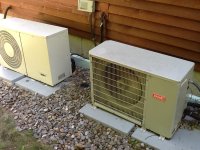This type of unit is being used more in the US for residential, especially in areas where ductwork isn't possible or desirable. Another plus is turndown capability, as you can turn off AC in vacant rooms more efficiently, and at a lower cost than having a multi-zone ducted system. Only downside to me is what to do with small rooms like bath, etc, and having to look at the units on the wall. In an area with vaulted ceilings where there's a lot of open space they are probably a good option, especially if you don't want to mess with ductwork.
Don't have a lot of direct experience with these, but suggest adding Daikin to the list of mfrs to check out. They have pioneered a lot of the newer, more efficient units, and definitely worth a look.
Residential | Product | Daikin Industries, Ltd.




